
ACCRINT function will return the accrued interest for a security that pays interest on a periodic basis.
The ACCRINT function is an inbuilt function in Excel which falls under the category of Financial Functions. It is a worksheet function. You can use this function as part of a formula in a cell of a worksheet.
Accrued interest is a term used in accrual accounting that disregards cash flows and reports interest earned but not collected. In simple terms, it is interest earned but not received (realized).
Syntax for the ACCRINT Function
=ACCRINT(issue, first_interest, settlement, rate, par, frequency, [basis], [calc_method])
Arguments
Issue: The issue date of the security/Investment.
First_interest: The security’s first interest date.
Settlement: The security’s settlement date.
Rate: The security’s annual coupon rate.
Par: The security’s par value. If omitted, [par] takes the default value of 1,000.
Frequency: The number of coupon payments per year (must be equal to 1, 2 or 4).
Basis: An optional argument, that specifies the day count basis to be used in the calculation.
Basis can be one of the following:
0 (or omitted) = US (NASD) 30/360
1 = actual/actual
2 = actual/360
3 = actual/365
4 = European 30/360
Calculation_method: An optional logical value that specifies the way to calculate the total accrued interest when the settlement date is later than the first_interest date. If omitted, [calc_method] takes the default value of TRUE.
Calculation method can be as following:
1 = TRUE
0 = FALSE
I have created the infographics for the ACCRINT Function. With the help of these infographics, you can easily learn step by step process for using this excel functions.
Furthermore, Excel consists of many inbuilt functions which are helpful in the analytical and statistical study of number.
Simply follow the instructions in the infographics below:

Common Errors in ACCRINT Function
#NUM! error occurs:
1. The supplied rate argument is ≤ 0 or the supplied [par] argument is ≤ 0.
2. The supplied frequency argument is not equal to 1, 2 or 4.
3. The supplied [basis] argument is not equal to 0, 1, 2, 3 or 4.
4. The supplied issue ≥ settlement.
#VALUE! error occurs:
1. The supplied issue, first_interest, or settlement arguments are not valid dates.
2. Any of the supplied arguments are non-numeric.
To learn other function like MID, QUOTIENT and KURT Functions, please click on the name of the function.
Additionally, you can download other accounting templates like Break Even Analysis Template, Salary Sheet Template and Invoice with GST Template from here.
We thank our readers for liking, sharing and following us on different social media platforms.
If you have any queries please share in the comment section below. I will be more than happy to assist you.
Leave a Reply